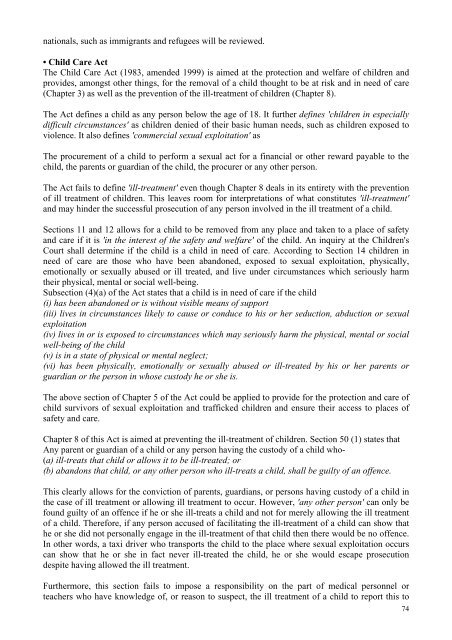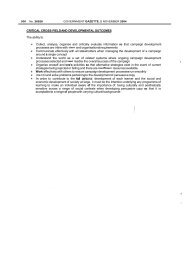The trafficking of children for purposes of sexual exploitation
The trafficking of children for purposes of sexual exploitation
The trafficking of children for purposes of sexual exploitation
Create successful ePaper yourself
Turn your PDF publications into a flip-book with our unique Google optimized e-Paper software.
nationals, such as immigrants and refugees will be reviewed.<br />
• Child Care Act<br />
<strong>The</strong> Child Care Act (1983, amended 1999) is aimed at the protection and welfare <strong>of</strong> <strong>children</strong> and<br />
provides, amongst other things, <strong>for</strong> the removal <strong>of</strong> a child thought to be at risk and in need <strong>of</strong> care<br />
(Chapter 3) as well as the prevention <strong>of</strong> the ill-treatment <strong>of</strong> <strong>children</strong> (Chapter 8).<br />
<strong>The</strong> Act defines a child as any person below the age <strong>of</strong> 18. It further defines '<strong>children</strong> in especially<br />
difficult circumstances' as <strong>children</strong> denied <strong>of</strong> their basic human needs, such as <strong>children</strong> exposed to<br />
violence. It also defines 'commercial <strong>sexual</strong> <strong>exploitation</strong>' as<br />
<strong>The</strong> procurement <strong>of</strong> a child to per<strong>for</strong>m a <strong>sexual</strong> act <strong>for</strong> a financial or other reward payable to the<br />
child, the parents or guardian <strong>of</strong> the child, the procurer or any other person.<br />
<strong>The</strong> Act fails to define 'ill-treatment' even though Chapter 8 deals in its entirety with the prevention<br />
<strong>of</strong> ill treatment <strong>of</strong> <strong>children</strong>. This leaves room <strong>for</strong> interpretations <strong>of</strong> what constitutes 'ill-treatment'<br />
and may hinder the successful prosecution <strong>of</strong> any person involved in the ill treatment <strong>of</strong> a child.<br />
Sections 11 and 12 allows <strong>for</strong> a child to be removed from any place and taken to a place <strong>of</strong> safety<br />
and care if it is 'in the interest <strong>of</strong> the safety and welfare' <strong>of</strong> the child. An inquiry at the Children's<br />
Court shall determine if the child is a child in need <strong>of</strong> care. According to Section 14 <strong>children</strong> in<br />
need <strong>of</strong> care are those who have been abandoned, exposed to <strong>sexual</strong> <strong>exploitation</strong>, physically,<br />
emotionally or <strong>sexual</strong>ly abused or ill treated, and live under circumstances which seriously harm<br />
their physical, mental or social well-being.<br />
Subsection (4)(a) <strong>of</strong> the Act states that a child is in need <strong>of</strong> care if the child<br />
(i) has been abandoned or is without visible means <strong>of</strong> support<br />
(iii) lives in circumstances likely to cause or conduce to his or her seduction, abduction or <strong>sexual</strong><br />
<strong>exploitation</strong><br />
(iv) lives in or is exposed to circumstances which may seriously harm the physical, mental or social<br />
well-being <strong>of</strong> the child<br />
(v) is in a state <strong>of</strong> physical or mental neglect;<br />
(vi) has been physically, emotionally or <strong>sexual</strong>ly abused or ill-treated by his or her parents or<br />
guardian or the person in whose custody he or she is.<br />
<strong>The</strong> above section <strong>of</strong> Chapter 5 <strong>of</strong> the Act could be applied to provide <strong>for</strong> the protection and care <strong>of</strong><br />
child survivors <strong>of</strong> <strong>sexual</strong> <strong>exploitation</strong> and trafficked <strong>children</strong> and ensure their access to places <strong>of</strong><br />
safety and care.<br />
Chapter 8 <strong>of</strong> this Act is aimed at preventing the ill-treatment <strong>of</strong> <strong>children</strong>. Section 50 (1) states that<br />
Any parent or guardian <strong>of</strong> a child or any person having the custody <strong>of</strong> a child who-<br />
(a) ill-treats that child or allows it to be ill-treated; or<br />
(b) abandons that child, or any other person who ill-treats a child, shall be guilty <strong>of</strong> an <strong>of</strong>fence.<br />
This clearly allows <strong>for</strong> the conviction <strong>of</strong> parents, guardians, or persons having custody <strong>of</strong> a child in<br />
the case <strong>of</strong> ill treatment or allowing ill treatment to occur. However, 'any other person' can only be<br />
found guilty <strong>of</strong> an <strong>of</strong>fence if he or she ill-treats a child and not <strong>for</strong> merely allowing the ill treatment<br />
<strong>of</strong> a child. <strong>The</strong>re<strong>for</strong>e, if any person accused <strong>of</strong> facilitating the ill-treatment <strong>of</strong> a child can show that<br />
he or she did not personally engage in the ill-treatment <strong>of</strong> that child then there would be no <strong>of</strong>fence.<br />
In other words, a taxi driver who transports the child to the place where <strong>sexual</strong> <strong>exploitation</strong> occurs<br />
can show that he or she in fact never ill-treated the child, he or she would escape prosecution<br />
despite having allowed the ill treatment.<br />
Furthermore, this section fails to impose a responsibility on the part <strong>of</strong> medical personnel or<br />
teachers who have knowledge <strong>of</strong>, or reason to suspect, the ill treatment <strong>of</strong> a child to report this to<br />
74
















